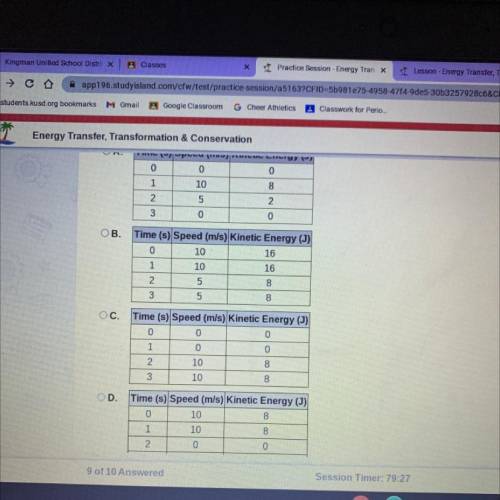
Physics, 18.02.2021 23:50 logan541972
In billiards, collisions occur between pool balls as they make contact with one another. In one particular collision, when all balls are
initially at rest, a white ball is struck with a stick and makes contact with a red ball. The table below summarizes the motion of the
white ball, with t = 0 when the white ball is initially struck by the pool stick.
Time (s) Speed (m/s) Kinetic Energy (J)
0
10
8
1
10
8
2
0
0
3
0
0
Assuming that the balls are on a surface with no friction, which table could summarize the motion of the red ball over the same time
period?


Answers: 2


Another question on Physics

Physics, 22.06.2019 02:10
Astudent is performing an experiment comparing sound and light waves. the student gathers the following data. what conclusion does the student most likely make based on this data? light waves always travel the same speed; however, the speed of sound is determined by the medium that it travels through. all sound waves always have the same energy, so the temperature of the medium does not affect wave speed. light needs to vibrate particles, so it travels fastest in tightly packed solids, while sound does not need a medium, so it travels fastest in a gas. tightly packed particles in solids slow down the light waves; however, sound waves make particles bounce into each other, so they travel faster in solids.
Answers: 3

Physics, 22.06.2019 02:30
Explain the difference between each pair of concepts. a. frequency and relative frequency b. percentage and relative frequency a. select the correct choice below. a. frequency is the total number of observations in a data set. relative frequency is the number of times a particular distinct value occurs. b. frequency is the number of times a particular distinct value occurs. relative frequency is the ratio of the frequency of a value to the total number of observations. c. frequency is the total number of observations in a data set. relative frequency is the ratio of the number of times a particular distinct value occurs to the frequency. d. frequency is the number of times a particular distinct value occurs. relative frequency is the ratio of the frequency of two different values.
Answers: 3

Physics, 22.06.2019 03:30
Two polarizers are oriented at 24.0∘ to one another. light polarized at a 12.0-degree angle to each polarizer passes through both. what is the transmitted intensity (%)?
Answers: 2

Physics, 22.06.2019 09:10
The diagram shows a series of volcanic island and a hot spot determine the direction of movement of the tectonic plate that for the island
Answers: 2
You know the right answer?
In billiards, collisions occur between pool balls as they make contact with one another. In one part...
Questions





Mathematics, 23.05.2020 22:00






History, 23.05.2020 22:00






Mathematics, 23.05.2020 22:00

History, 23.05.2020 22:00


Mathematics, 23.05.2020 22:00



